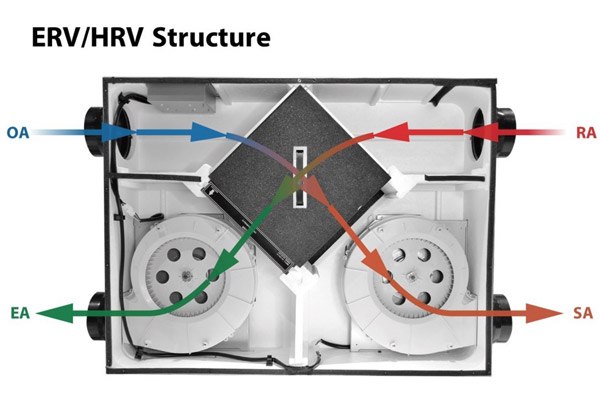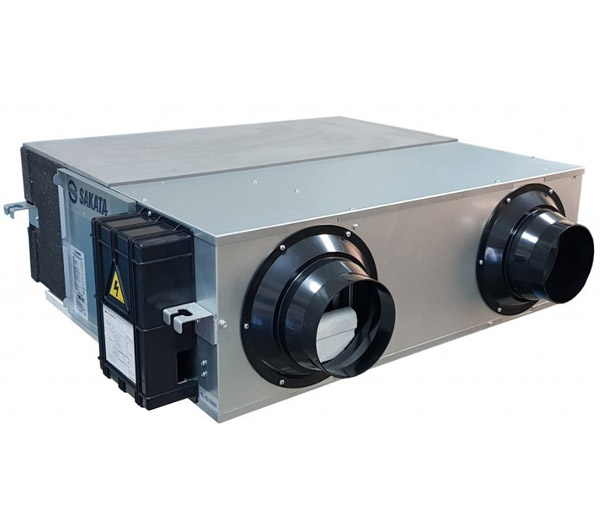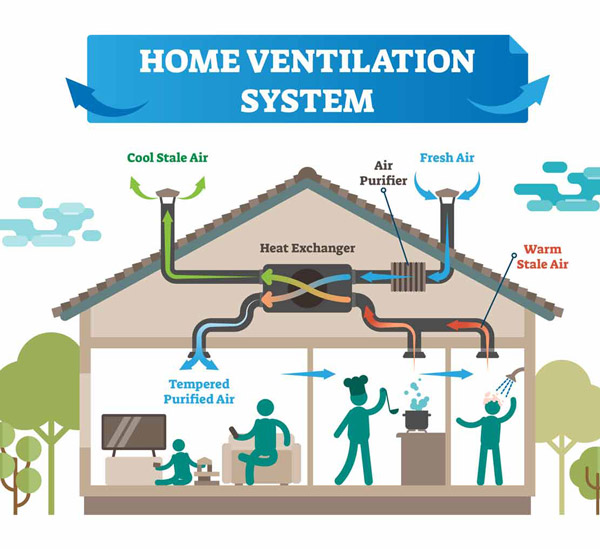
When natural ventilation does not maintain the necessary speed of air exchange and the air quality is not perfect at all, people resort to heat and energy recovery ventilators. The heat recovery systems use the energy of exhausted air masses to heat up the fresh air, which is driven in by a ventilator.
Heat Recovery Ventilator System Service, CO
The Best Heating Cooling & Air Company in Denver, Colorado, professionally installs the HRV and ERV systems. We also help you adjust the necessary heat recovery to save all warmth inside your house!
Heat recovery ventilator system expert in Colorado
The heat recovery technology has a large potential for energy saving. But in order to implement all the capabilities of an HRV system in a specific object, the design and installation must be carried out by extra class specialists. The BHCAir Company, a certified NATE contractor, has the Xcel Energy recommendations and has all the necessary resources and allowances to install and maintain innovative ventilation systems. You will work with a team of licensed technicians who have diplomas from EPA. The team includes a manager, who organizes the HRV installation on your premises within a reasonable time.
Such a complex device as the heat recovery ventilator system is designed and selected individually based on the parameters of the premises and microclimate. We consider all the nuances to adapt the HRV service to the specificity of each object, making sure the maximum efficacy and the reliability of the installed device, given the minimum cost for a piece of equipment, so you will have no reason for discontentment!
ERV and HRV in Colorado

Colorado’s climate is close to continental: frosty winters and hot summers force people to search for options to improve their climate control systems. In order to reach a required level of comfort in any season, it is important to provide a sufficient air exchange level in a building that has a high degree of sealing; the Denver area installation of heat recovery ventilator fully suffices.
Among the contractors in the Colorado area, the BHCAir Company takes leading positions. In addition to Denver, we also have branches in Castle Rock, Aurora, Littleton, Parker, and Highlands Ranch. We accept your applications for our work at any time of the day and we offer the ERV and HRV systems installation at an affordable price, giving a 100% warranty for all types of work that we do. Our clients also can participate in a program to compensate for their expenses when they buy branded equipment.
Why do we need heat recovery?
Heat recovery systems are highly versatile. An HRV system offers an elegant and witty solution to save energy and strengthen the microclimate in living and commercial premises. Given the cold climate, the building walls are thoroughly compacted, which makes it harder for natural supply and exhaust ventilation to work. So the buildings have areas of air masses idleness, where water vapor is condensed along with malodors and various contaminants:
- dust and small garbage
- pieces of soot, smoke, and smog
- down and pollen of plants
- spores of molds
- pet hair
- toxic gasses (carbon monoxide, carbon dioxide, radon, and nitrogen dioxide)
- volatile organic pollutants: methane, formaldehyde, phenols, etc.
Breathing contaminated air is dangerous for health. When a person doesn’t have enough oxygen, they have a headache, problems with clear thinking, and they find it hard to do their normal work. The excess carbon dioxide creates an extra load on the respiratory and cardiovascular systems. Chronic intoxication and irritation of the respiratory tract with various contaminants lower the capability of the human body to withstand infections and respiratory diseases. Along with dust, various microorganisms get inside the house to remain there.

Dampness is a constant partner for congestions: condensation of water vapor on walls leads to the deterioration of finishing materials and contributes to mold growth. Spores of black and green mold are very powerful allergens, which suppress people’s immunity and are cancerogenic.
The equipment also suffers from the unhealthy microclimate: in dusty and damp premises, electronic devices might function incorrectly and have a decreased lifetime. Because of a high concentration of carbon dioxide, the air inside the premises is constantly overheated, which pushes the air conditioners to wear out faster because of harder work and so house owners should spend their incomes’ lion’s share to repair their climatic equipment.
Heat recovery systems are able to compensate for the system vices of badly ventilated premises: the restoration of normal air circulation thanks to mechanically induced ventilation normalizes the level of humidity, contributes to air self-purification, and removes a lot of pathogenic factors along the way. In addition to that, there are no drafts on the premises, the heat won’t leave the house, and so you don’t have to worry about the increased utility bills for your heating since the HRV system lowers the energy resources consumption.
Advantages and disadvantages of HRV

A heat recovery system is one of the most cost-effective devices of forced ventilation for the private sector: more than half of exhaust air returns to the system while the most advanced systems provide this percentage as high as 90-95%. The heat energy of the exhausted air is transformed into electric energy, which powers up supply fans. Typically, one would save 50-100 W, sometimes, even up to 300 W. Decreasing the connected load is not the only argument in favor of HRV systems; there are multiple other advantages:
- the device effectively works for both heating and cooling
- an HRV system is designed to be compact and high-efficient at the same time
- its central block does not take up much space
- air filters with a high MERV rating make sure deep air purification
- silent fans
- microclimate smart control system through the network of sensors operatively reacts and adjusts to temperature and humidity changes in the premises
- low carbon footprint.
On the other hand, heat recovery shan’t be considered a universal solution in just all circumstances: HRV and ERV systems demand thorough heat and air insulation; the initial investments are thousands of dollars. However, the system has fast recoupment in the conditions of a humid continental climate. Heat recovery works well in subarctic regions as well but there will be the need to take measures to prevent icing, which also costs additionally.
Just as the rest of high-tech devices, an HRV system requires regular service maintenance and filter change (not less frequently than once every 6 months). Finally, heat recovery might not be able to deal with a high concentration of contaminants and pollutants — in this case, one would need to install professional equipment to purify the air.
How does the HRV/ERV system work?
In heat recovery devices, the exhausted air is returned to the heat exchanger and is mixed with the fresh incoming air. As a result of that process, there is heat exchange. Further, exhaust masses are removed through air ducts while the warmed-up incoming air goes inside the premises through a filter, which removes dust and chemical contaminants from it.
In ERV systems, some small volume of water vapor is added to the incoming air, which prevents the air from becoming too dry. In addition, humidified air decreases the workload of air conditioners and provides dampness protection in rainy regions; HRV systems are best for dry regions and non-conditioned premises.
Ventilation and certification strategies for an energy-passive building
HRV and ERV systems are crucial for the implementation of energy efficiency standards, which are prescribed by the voluntary certification system for energy-passive buildings. Those building owners, which would like to receive such a certificate for their buildings, have to make sure the energy and heating efficiency indices in their objects are 80% higher than regulatory numbers while energy consumption does not increase one-tenth of resources, which are consumed by standard buildings.
In order to improve the energy-saving qualities of buildings, innovative heat insulation materials with a prolonged term of service are applied. To improve the air quality inside the premises, the arrangement of mechanical ventilation with a heat recovery unit and filters in the supply and exhaust ducts are designed.
Sticking with the energy-passive house standards lowers operating costs and prolongs the life term of equipment. The BHCAir Company has successful experience in the design and implementation of ventilation and air conditioning systems for energy-passive buildings and we’d be thrilled to implement our skills in your project!
HRV installation
The installation of a heat recovery system begins with the design of an individual project based on the premises’ measurement and the analysis of engineering design solutions. To achieve optimal indicators of air exchange and energy efficiency, the ventilation and climate control system air ducts must not cross; also, we consider the object’s exploitation conditions and the personal desires of our clients.
After the project is designed and approved, the installation team starts their work; the work schedule is designed based on the day’s schedule of a client; for commercial clients, it is possible to make HRV installation in off-hours. After the installation is complete, the team does the commissioning and testing of equipment. After that, they make the commissioning act, which is signed by the client and the installation team leader.
A balanced heat recovery ventilator is able to save energy and increase comfort
When HRV and ERV systems are designed, close attention is paid to the calculation of the air balance: your comfort will depend on the balance of air inflow and outflow. Lack of inflow air increases the contaminants’ concentration; the accumulation of exhaust air masses inside the premises creates conditions for mold growth.
When balance equations are made, it is important to balance positive and negative heat loads, considering the main sources of heat gain and loss. The BHCAir Company’s engineers are skilled and knowledgeable enough for a creative approach when they solve even the hardest and most captious technical tasks!
Call the Best Heating Cooling & Air Company to choose an HRV solution for you
The BHCAir Company specializes in the design and installation of HRV and ERV turnkey: we do the entire cycle of work without resorting to any third-party companies. All links of the process are ideally verified and optimized in terms and cost; so you only have now to book an expert consultation to clarify the details of our offer. And if you already have a heat recovery device installed, we can offer you professional heat recovery ventilator system service to reach maximal energy efficiency. Allow yourself to dare — together with us!











